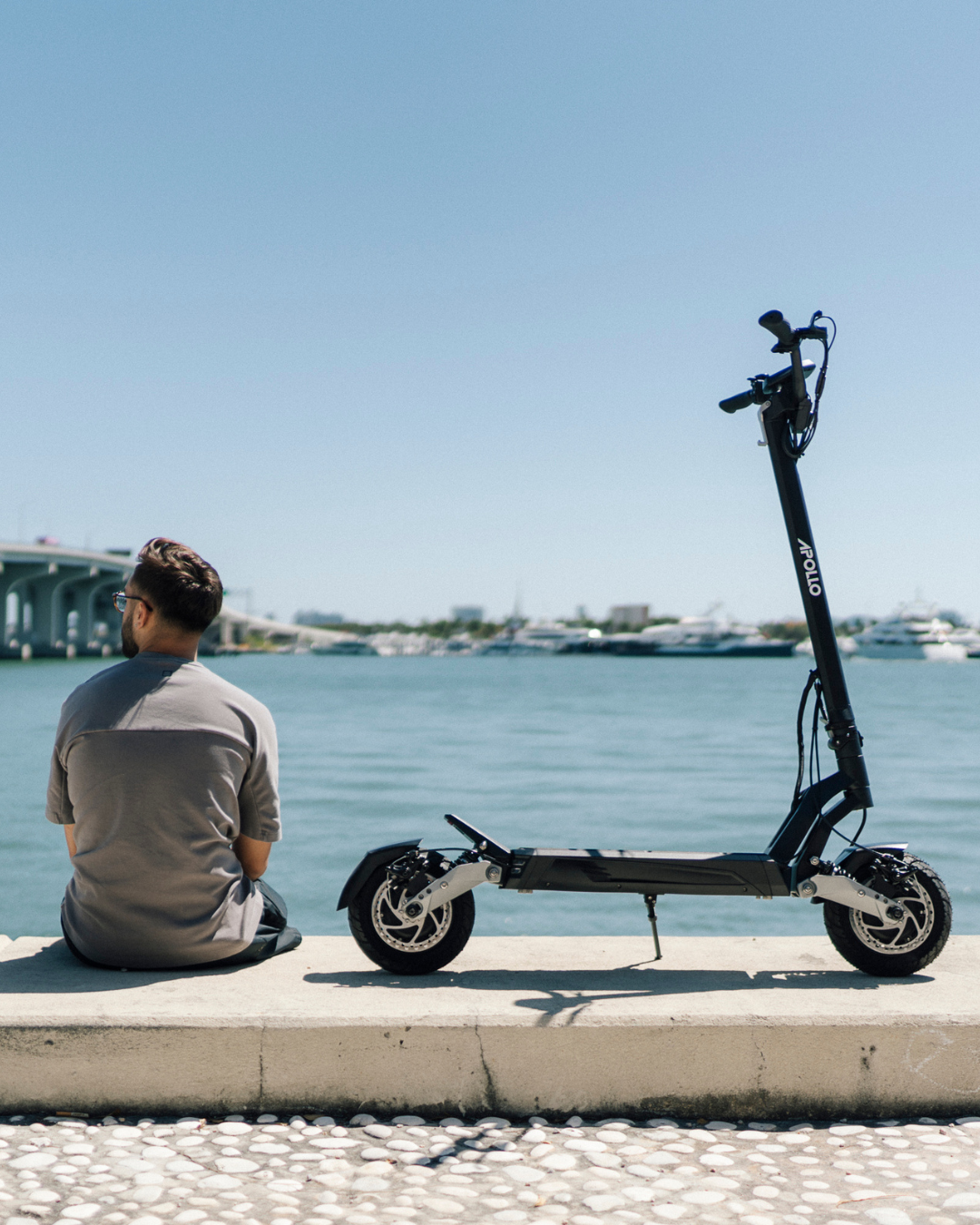Electric scooter sharing is a micromobility solution that surged around sometime 2010 (depending on where you live). It allows riders to easily rent e-scooters through a mobile app. In the beginning, most programs offered dockless programs, nowadays most of the sharing programs are docked - for multiple reasons that we’ll discuss later on.
Electric scooter sharing is a practical way to get around town, but it’s mostly ideal for last-mile transportation—the short distance between transit stops and a rider’s destination. This mode of transportation grew rapidly during the first years - but it had a boom during COVID-19 as it was an excellent alternative way of moving around while avoiding being too close to somebody else. It’s continued to become more popular as cities get busier and busier, and scooters are a faster, practical and FUN way to get around.
How Does Scooter Sharing Work in Cities
While there may be variations on how the program works depending on where you live, most scooter sharing programs can be used through mobile apps. First, you have to download the app and subscribe to the program, and then through the app you’ll be able to:
-
Locate scooters using GPS-enabled maps
-
Unlock scooters by scanning a QR code
-
Ride and pay based on distance or time traveled
-
End your ride at designated areas or docking stations
As long as you know how to handle a smartphone, the rest is easy. And that’s why the model spread out wide and fast in major urban centers, where congestion and limited parking make traditional transportation less appealing.
Now at this point, you’re probably wondering. If it’s so great, why aren’t they available everywhere? Well, we’ll delve more into the challenges of scooter sharing later on, but in short electric scooters adoption spread too quickly and cities took too long to start regulating its ownership and use which caused major accidents and problems for the communities. With a lack of understanding of the program and regulations to implement, cities banned and limited the use of electric scooters until there was a better understanding.
Key Benefits of Scooter Sharing for Urban Mobility
If you have ever used an electric scooter - you’re aware that they are an amazing way to get from point A to point B, but scooter sharing has additional benefits than owning an electric scooter:
-
Convenience: Pick it up and leave it behind. It’s quick and easy for short trips, especially if you want to change mode of transport on the way back (or combine means of transportation).
-
Reduced congestion: Scooters take up less road space than cars, easing traffic in dense areas, but most importantly - they allow you to skip traffic lines!
-
Cost-effective: Lower cost than taxis, ridesharing services for short journeys or better yet, than owning a car.
-
Sustainable commuting: If you’re conscious about the environment, zero-emission rides help reduce pollution and carbon footprints. (Assuming your city is powered by clean energy).
-
Healthier cities & lifestyle: This is the biggest point we hear more from all of our riders - riding a scooter vs sitting in a car is significantly more enjoyable - it simply changes your mood and makes your day better.
👉 Bottom line: Scooter sharing fits perfectly into the future of shared mobility and urban transportation innovation.
Challenges and Controversies in Scooter Sharing Programs
Despite so many good things that electric scooters have brought - there’s also downsides (just like everything). Here’s some of the bigger problems we’ve seen around the world:
Concerns that the community voices:
Safety:
Unlike motorcycles or almost any other motor vehicle, most cities do not require riders (yet) to have a license or permit to drive electric scooters. Yet, some of them do travel at high speeds - imagine 80 km/h - which is even faster than the top speed allowed in most city streets. With little to no control over electric scooters, this has inevitably led to major accidents to riders and caused by riders. This has led to a rejection from people within communities due to a potential hazard to pedestrians and other vehicles.
In Canada for example, 1,000 people were hospitalized in 2023-2024 due to electric scooter injuries, more than 20% up from the previous period with 881 hospitalizations CBC and just over 6,000 in USA, double the amount of Ebike injuries in the same period UCSF.
And this is just to state a few examples.
Sidewalk clutter & public nuisance:
We previously mentioned two different types of programs. Dockless - which means that riders can leave and thus pick up the scooter anywhere within a designated area, and dock stations - designated stations where scooters are left and picked up; they are strategically thought to avoid being in an inconvenient spot for pedestrians and vehicles.
When scooter sharing first came to life, most programs were dockless simply because it’s more convenient for riders, and also easier to manage for the business. Think about it, as a rider you find the scooter closest to you & then you can leave it right at the doorstep of wherever you’re going; on the other hand as a business, it’s also easier to manage to some extent because you don’t have to worry about full or empty stations.
Fun fact: did you know that one of the current biggest problems of managing scooter and bicycle sharing programs is balancing docks? Just like with cars, there’s a flow of people in the morning (all want to park in one same spot) and another one in the afternoon, where they need the dock that needs to be empty in the morning to be full and the one in the morning empty. And figuring out the right balance of empty sports and full spots on a given station is tricky. Similar to car traffic, electric scooter sharing programs experience a surge in demand for parking spots in the morning and a need for empty docks in the afternoon. Maintaining an optimal balance of available and occupied spaces at each station is a challenge.
This begs the question, if it’s so convenient, why not just go dockless? Well, the simple answer is because riders simply are not responsible enough. Riders proved to leave scooters in inappropriate spaces, sometimes in the middle of sidewalks which prevented pedestrians from being able to pass through; sometimes on the street, which resulted in scooters being damaged, and finally it also resulted in stolen scooters.
So most cities that initially allowed shared scooters, decided to ban them (or simply businesses decided to stop the programs) and just recently have started bringing in pilot programs to test them out again - with more control and rules in place.
Some examples are Mexico & Montreal.
Regulatory issues:
This is one of the most important points and it’s a bit of a chicken and it presents a "chicken and egg" dilemma. See, electric scooters adoption happened all of a sudden and so quickly, leaving governments (who are typically slow to implement regulations) - with no real, immediate solution.
It's only until the last couple of years that special regulations have been implemented around the world. NSW, Australia for example, only started a pilot program this year and similarly Montreal starting in summer 2024, it was only a couple of cities that were fast to react, like Portland who began the first pilot program in 2018.
This is only the beginning and we expect further regulations, potentially including a permit requirement for operating higher-speed scooters.
Challenges for the sustainability of the programs:
Just like in any other business, there’s challenges to profitability. In the case of electric scooters, there’s two major challenges inherent to the industry.
Weather & seasonality:
Ridership drops significantly during colder & wetter months. At first glance, this could seem insignificant, but it brings other problems along. First and foremost: storage. Businesses need to solve what to do with the scooters during the offseason. Scooters can’t be left out to endure the seasons (cold & wet weather cause damage to the batteries). Meaning that the economics of the program need to be strong enough to fully function for 6 to 8 months, and stop completely (or almost completely) during 4 months of the year.
Product misuse:
Back in the early days of shared scooters, most systems were dockless—and the results weren’t always pretty. Scooters were left scattered everywhere: abandoned in the middle of streets, tossed into rivers, or simply stolen.
The introduction of docking stations helped solve much of this problem. By making riders responsible for returning scooters to a dock, it created accountability and order. Plus, docks make it far harder to steal a scooter compared to one left unattended on the street (after all, scooters aren’t that heavy to carry away).
Future Trends in Electric Scooter Sharing and Infrastructure
Looking ahead, several trends are shaping the future of scooter sharing:
-
Integration with public transit: Seamless connections with buses, trains, and subways for efficient last-mile transportation.
-
Stronger regulations: Clearer city policies on safety, parking, and fleet management
-
Improved scooter durability: More rugged designs to withstand heavy use and varied climates
-
Sustainable infrastructure: Charging hubs and dedicated lanes to support sustainable commuting
-
Smart city adoption: Using transportation innovation and data to integrate scooters into broader mobility ecosystems
Electric Scooter Sharing vs Electric Scooter Ownership
While we’d love to say “Owning an electric scooter all the way” - the reality is that there’s advantages and disadvantages to both. Let’s walk through the top 4 decision points:
Everyday Convenience
Owning an electric scooter comes with a unique kind of freedom. You don’t need to worry about finding a dock or checking availability—it’s always there, always yours, ready to take you anywhere. With longer-range models, you’re not limited to short trips. You can ride all day, explore new neighborhoods, or head out on an adventure—something rentals simply can’t offer.
On the flip side, shared scooters have their own perks. You don’t need to think about charging, maintenance, or storing it in the off-season. Once you park, it’s no longer your responsibility. They give you flexibility too—if you decide to take a different form of transportation home, you can simply leave the scooter behind.
Riding Comfort
If you’ve only ever tried shared scooters, you might not realize what you’re missing. Take a closer look: shared e-scooters are built to be durable and cost-efficient for the operator, which makes them heavier, bulkier, and stripped of comfort features. That durability comes at the rider’s expense.

(Apollo Phantom 2.0 Stellar)

Lime shared e-scooter
Owned scooters, on the other hand, are designed with the rider in mind. You get to choose a model that fits your needs and comfort level. Most quality scooters come with suspension (and the higher-end you go, the smoother it gets). That means the same bump in the road can feel like a jarring pothole on a shared scooter—or practically nothing at all on your own.
If you’re riding daily, suspension and stability aren’t luxuries—they’re must-haves. Premium scooters are easier to keep steady, require less effort to stay straight, and feature smoother throttles that save your thumbs from strain. And with Apollo, you can even personalize your ride through the app so it feels made for you.
When it comes to comfort and ride quality, owning your scooter is the clear winner. No debate.
Good for the Wallet
When it comes to cost, there isn’t a universal “best” choice—it really depends on how you plan to use your scooter (and on the pricing of your local e-scooter sharing program). Here are some things to consider:
Owning your scooter
Let’s take the Apollo Go as an example. It’s designed for commuting, not the cheapest option, but a good balance of durable and comfortable. If you maintain it well, you can expect 3–4 years of use.
Here’s some quick, conservative math:
-
Usage: 5 days a week, 2 trips per day.
-
Allowing for downtime, say 45 weeks per year.
-
Over 3 years, that’s about 1,350 trips.
If your scooter costs around $1,000, that works out to just $0.75 per trip—or $1.41 per day.
You live in a snowy place? Let’s assume 4 months of downtime, that's 1,080 trips. Resulting in $0.92 per trip, or $1.85 per day, it’s still a fairly small amount.
Using shared scooters
Shared scooters can be the cheaper option in the short run (say, under a year). But if you’re relying on them as your main mode of transport, the numbers change quickly.
Here’s why:
-
Average cost: about $0.30 per minute and in most cases a $1 unlock fee.
-
Typical ride: ~20 minutes → $7 per ride (UCDAVIS)
That means if you ride 160 times (That’s roughly 4 months of commuting twice a day, 5 days a week), you’ve already spent $1,120, which is more than owning your very own Apollo Go. Crazy right? Now, we’re not trying to convince you to get an Apollo Go right this minute - if you’re thinking of using the scooter once in a while or if you’re out of town regularly, it may just be better for you to subscribe to a rental program. It will be more convenient for you.
Riding for Fun
Saving the best for last. Let’s be honest—riding an e-scooter is fun no matter what. But when it comes to how much fun you can actually have, there’s a clear winner.
With shared scooters, the fun is capped. Imagine trying to take a one-hour ride—it would cost a fortune. Plus, providers limit speed, range, and even where you can ride.
Owning your own scooter, on the other hand, opens up a whole new world. You can go off-roading, bring it on a road trip, or simply ride longer and faster (where it’s legal, of course). The extended range and higher top speeds mean more hours of freedom—and more fun.
In the end, it’s not about which is “better.” It’s about what fits your lifestyle. If you’re after flexibility without commitment, a shared scooter might be enough. But if you want unlimited fun, owning your own is hard to beat. And if the budget allows—why not do both?
How Cities Can Prepare for Scooter Usage Growth
For scooter sharing to thrive, cities must:
-
Build dedicated scooter lanes and parking areas
-
Enforce safety measures like helmet use and speed limits
-
Partner with scooter operators to share mobility data
-
Educate riders on responsible scooter use
With the right approach, public scooter programs can help create cleaner, less congested, and more connected urban environments.
Final Thoughts
Electric scooter sharing is more than just a trend—it’s a powerful shift in how we think about urban transportation. By offering eco-friendly, cost-effective, and convenient shared mobility, these programs are reshaping the way people move through cities.
The challenge now lies in balancing innovation with safety, regulation, and infrastructure. If cities and operators get it right, electric scooter sharing (and electric scooter ownership) could play a central role in the future of sustainable commuting and transportation innovation.







